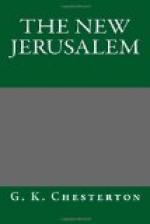When the critic says that Jerusalem is disappointing he generally means that the popular worship there is weak and degraded, and especially that the religious art is gaudy and grotesque. In so far as there is any kind of truth in this, it is still true that the critic seldom sees the whole truth. What is wrong with the critic is that he does not criticise himself. He does not honestly compare what is weak, in this particular world of ideas, with what is weak in his own world of ideas. I will take an example from my own experience, and in a manner at my own expense. If I have a native heath it is certainly Kensington High Street, off which stands the house of my childhood. I grew up in that thorough-fare which Mr. Max Beerbohm, with his usual easy exactitude of phrase, has described as “dapper, with a leaning to the fine arts.” Dapper was never perhaps a descriptive term for myself; but it is quite true that I owe a certain taste for the arts to the sort of people among whom I was brought up. It is also true that such a taste, in various forms and degrees, was fairly common in the world which may be symbolised as Kensington High Street. And whether or no it is a tribute, it is certainly a truth that most people with an artistic turn in Kensington High Street would have been very much shocked, in their sense of propriety, if they had seen the popular shrines of Jerusalem; the sham gold, the garish colours, the fantastic tales and the feverish tumult. But what I want such people to do, and what they never do, is to turn this truth round. I want them to imagine, not a Kensington aesthete walking down David Street to the Holy Sepulchre, but a Greek monk or a Russian pilgrim walking down Kensington High Street to Kensington Gardens. I will not insist here on all the hundred plagues of plutocracy that would really surprise such a Christian peasant; especially that curse of an irreligious society (unknown in religious societies, Moslem as well as Christian) the detestable denial of all dignity to the poor. I am not speaking now of moral but of artistic things; of the concrete arts and crafts used in popular worship. Well, my imaginary pilgrim would walk past Kensington Gardens till his sight was blasted by a prodigy. He would either fall on his knees as before a shrine, or cover his face as from a sacrilege. He would have seen the Albert Memorial. There is nothing so conspicuous in Jerusalem. There is nothing so gilded and gaudy in Jerusalem. Above all, there is nothing in Jerusalem that is on so large a scale and at the same time in so gay and glittering a style. My simple Eastern Christian would almost certainly be driven to cry aloud, “To what superhuman God was this enormous temple erected? I hope it is Christ; but I fear it is Antichrist.” Such, he would think, might well be the great and golden image of the Prince of the World, set up in this great open space to receive the heathen prayers and heathen sacrifices of a lost humanity. I fancy he would feel a desire to be at home again amid the humble shrines of Zion. I really cannot imagine what he would feel, if he were told that the gilded idol was neither a god nor a demon, but a petty German prince who had some slight influence in turning us into the tools of Prussia.




